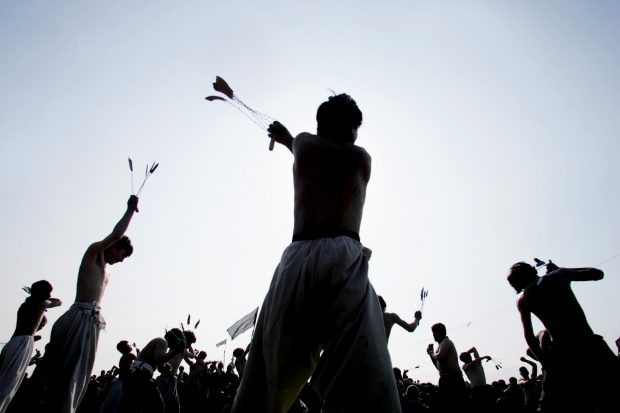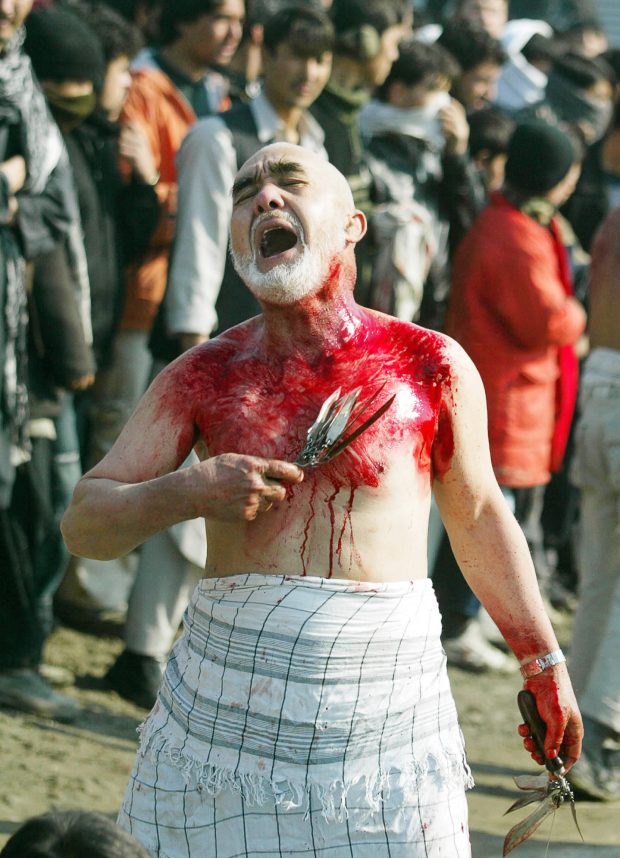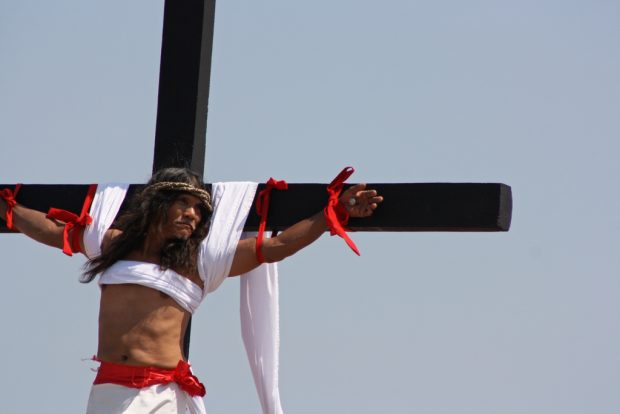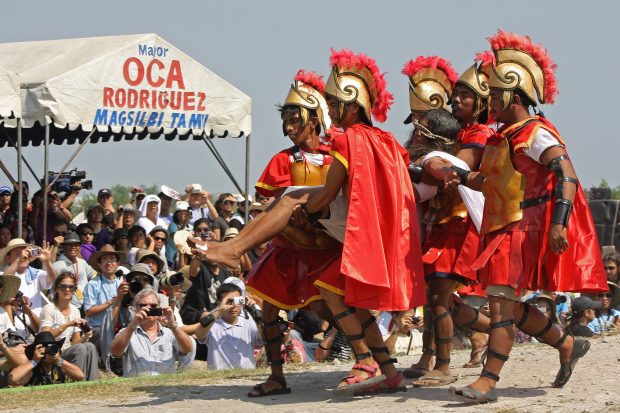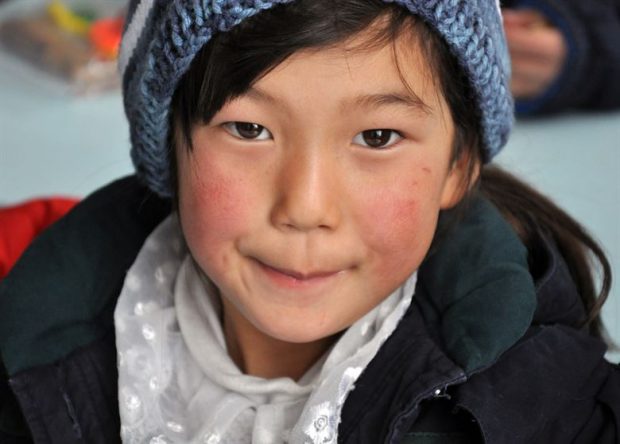Obscure and Unknown Asia
Ever think you’ve known all there is to know about a country? Well, think twice, because you will find on the following pages religious, spiritual, and cultural practices in Asia that, for the most part, have not been well-known around the world. These rituals take diverse shape—speaking for the lives and values of people groups dispersed across the continent—but they also bring together such people with the deeper understanding that life is about our habits. The way we think influences all aspects of our lives, and as beings that feed on action, our customs reveal aspects of our soul.
Take a closer look at each of our obscure rituals and traditions, beginning with the religious and spiritual rituals of Ashura, crucifixion reenactment, hanging coffins, and then the cultural traditions of baby tossing and bride kidnapping in the hidden areas of our Asian border.
As a disclaimer, the respective content in our feature is often associated to rural Asian regions—hence, the reason why they are being considered obscure and unknown rituals. -Reporter’s Note
Ashura
Literally meaning “ten”, Ashura marks the 10th day of the first Islamic month, Muharram. Each year, on Ashura, Muslims around the world take to the streets to commemorate a day that means different things for different Muslim sects.
Sunni Muslims say Ashura is a day of fasting for two reasons: it is said that Prophet Muhammad fasted during this time and before him, Moses, prophet of the Israelites, fasted to thank Allah for saving the people from slavery. Other Muslims see it as the day Noah left his ark after Allah’s great floods.
More importantly, however, is what Ashura has come to mean for Shia Muslims. The Shiites consider Ashura a day of mourning for the death of Husayn—grandson of Muhammad—in 680 AD at Karbala (modern-day Iraq), on the tenth day of Muharram.
At the time, the Shia were a political faction of Ali who was the fourth caliph (spiritual authority), son-in-law to Prophet Muhammad, and father to Husayn. Upon Muhammad’s death, disagreement over succession of leadership led to division between Ali’s followers and those who supported his opponent, Muawiya. At one point of the conflict, during the Battle of Karbala, Husayn was brutally killed for supporting his father. This became the separation of Islam into the largely Shiite and Sunni denominations.
To this day, Husayn is celebrated as hero of the Shiites who, on Ashura, reenact his death to commemorate the act of martyrdom. Shia men and women, often in rural Shia communities, dressed in black parade through streets hitting their chests and chanting. Sometimes, they will undergo rituals of self-injury by whipping themselves with metal chains (called Tatbir/Talwar Zani) or cutting their foreheads till blood pours down (Matam).
Ashura, therefore, is a day symbolizing “the Shia cult of martyrdom and to their sense of betrayal and struggle against injustice, oppression, and tyranny” (BBC report). Today, Shiites make up Islam’s second-largest denomination (around 15 percent of the world Muslim population) and still believe Husayn to be the one true heir of Prophet Muhammad.
In 1994, fearing the practices as being dangerous, Iran’s Supreme Leader Ali Khamenei issued a decree against self-mutilating Ashura rituals. Sometime after, even Hezbollah, the militant Shia group, repeatedly asked Shia Muslims to donate blood to hospitals instead of cutting themselves to bleed.
Though sayings such as, “Let not your own hands contribute to your destruction” can be seen in the Quran, Tatbir and Matam continue to be practiced annually by devout Shiites as the only way to express the deep sorrow of the Islamic divide in 680 AD.
Philippines Crucifixion
“The first time I was nailed to a cross, I was terrified, but I prayed to Jesus to take the pain. Now, I don’t feel anything. It’s like getting an injection.” -Laranang, who experienced crucifixion (Reuters).
Easter. For most of the world’s Christian population, Easter is seen as a day to remember Christ’s death and resurrection. Festivities include Easter-egg hunting and church services spent in joyful peace with the knowledge that one’s sins have been forgiven through Jesus’ cross.
But that cross is seen quite differently in the Philippines, especially in Pampanga, located in central Luzon, the largest and most populous island of the country.
On the weekend of Easter, beginning with Good Friday, many flock to the area to see dozens of devotees imitating Christ’s suffering. They are first flogged with long wooden sticks and then are made to carry heavy wooden logs that will be used as the cross. Once the cross has been assembled, real nails are hammered into devotees’ hands and feet to complete the full imitation of the pain Christ experienced. Those who voluntarily undergo the ritual understand it as an outpouring of their faith, and an expression of loyalty to their lord.
Although reenactment of crucifixion has also been seen in areas close to Manila the tradition takes place mostly in Pampanga, with its “origins in a dramatic version of the Passion of Christ written by a local playwright in the 1950s, leading to the first crucifixion [there] in 1962” (CNN).
Those who choose to be crucified often do so to repent of sins committed, or in gratitude of the many blessings they received in the past. More frequently, however, are those who believe that such extreme acts will bring luck and divine help. Meanwhile, medical personnel wait below in case of emergency situations.
Catholic religious authorities in Pampanga disapprove of the crucifixions and have said, “[Believers’] acts should be geared toward good works. Christian life is not something that is done overnight,” according to The Telegraph report. Many have said that it has become an act of mysticism blinded by personal desire and is not genuine to the Christian faith. Nevertheless, Good Friday activities with bustling town markets and event halls account for a large fraction of Pampanga’s local business profits.
The act of devotion obviously comes with its scars; devotees say the wounds can take as long as two weeks to heal—but are considered only small price to pay for the amount that they will receive from God. “My faith got me through my illness. I will continue doing this for as long as I live,” a man, Wilfredo Salvador, said as he came down from a cross (The Telegraph).
Hanging Coffins
Some coffins are left to hang on cliffs. They can be found in various locations such as in China and the Philippines.
In South-eastern regions of China, between the regions of Yunnan and Sichuan, there are vertical cemeteries. The ritual was first practiced by the Bo, an ethnic minority people who created for themselves a vibrant culture as early as 3,000 years ago. The Bo differed from other ethnic groups in their burial customs. Typically hewn from durable hardwood logs, their hanging coffins went unpainted. The hanging coffin was the most widespread form of burial in ancient southwest China. However, the practice ended with the mysterious disappearance of the Bo people. “It is something unique and mysterious,” once declared by explorer Wong How Man.
Hanging coffins come in three different types: supported on wooden stakes, placed in cliff caves, or on projections in the rock. Some of these coffins were hung at least 10 meters above the ground with the highest ones reaching 130 meters. Experts are still trying to figure out how the Bo were able to reach such heights without proper equipment. Maybe that’s why there used to be ancient legends that the Bo could fly.
Even so, why did the Bo go about using this burial custom? Based on a practical reason, they wanted their coffins to be protected from enemies and animals. Researchers also suggested a spiritual motivation: the Bo may have believed heaven existed in the sky. According to this theory, hanging coffins became the stairs to the heaven.
Through analysis of Bo culture, explorers also discovered that the ancient population treated the dead as though they were still alive; they believed the deceased had simply moved to a new place where they would go on to carry normal lives. For this reason, the Bo provided day-to-day items inside the coffins.
Hanging coffins are also an ancient funeral custom in Northern Luzon, Philippines. The Igorot tribe has practiced such burial for around 2,000 years, believing that this location gives the dead closer access to heaven. In several areas, coffins of various shapes and sizes can be seen again, hanging either on beams projecting outward from vertical faces of the mountain, in caves in the face of cliffs, or on natural rock projection. The coffins are quite small due to the fact that the dead were buried in fetal position. This was because the Igorot believed that people should leave the world in the same position as they entered it (CNN).
It is, without a doubt, fascinating to see how cultures located far from each other and from different times took on similar beliefs and traditions that reveal their core values and worldviews.
Baby Tossing in India
One would think parents would never put their baby in harm’s way. A number of families in rural Maharashtra and Karnataka (southern Indian States), however, are known to practice a ritual dating back to almost 700 years—baby tossing over buildings.
According to a New York Times finding, the ritual is based on a legend back when infant mortality rates were dangerously high. A saint suggested parents with dying children to “build a shrine and drop the ailing infants from the roof to show their trust in the almighty.” The babies, again, based on the myth, were healed of their sickness.
And so, the tradition continues in rural communities where fertility rates remain low compared to urban areas. Families gather at their local shrine with the priest ready to toss babies and family members waiting below with an outstretched blanket. The custom is repeated by other families so that their child, too, would be blessed with health and good fortune.
Once the baby has been caught by the blanket, shouts of joy and cheering is heard amongst all those watching.
Local villagers have said the tossing is harmless to children, and it seems it has continued because of its ancient cultural value provided that both Hindus and Muslims in the region took part in the ritual.
Unfortunately, in 2009, a clip revealing the practice was made public to internet users causing widespread outrage for overlooking the psychological risk of scaring such young babies. Some refused to acknowledge that such behavior existed in India claiming they had never see anything like that happen anywhere in the country.
With that incident, local campaigners called for the attention of India’s National Commission for Protection of Child Rights and by 2011, tossing was made illegal. Lov Verma, from the National Commission said at the time, “I’m absolutely shocked by this. It’s not simply the government’s job. We need to educate all those who take part in this barbaric practice—the temple priests and the community.”
And yet, reports have found the tossing has not stopped and some babies not more than two months are thrown over shrines. Research on the ritual still needs time to observe any real damage of being tossed, but it is yet a cultural aspect locals hope to preserve.
Bride Kidnapping in Kyrgyzstan
In rural Kyrgyzstan, men often marry women abducting them off the street and forcing them to be their wife. Sometimes the bride and the groom already know each other and are in a relationship; sometimes not. The ritual begins with a good-luck blessing given to the future husband and his friends. Then, they kidnap the woman from the street and drive her to the man’s house, where all the female members of his family try to convince her to wear the bridal veil. The process may take hours or even days. Once she accepts, a delegation from the husband’s family visits her house, asking her parents to agree to the marriage. Finally, after an informal wedding, the ceremony is celebrated by an official imam. The tradition also includes the showing of bloody sheets: a sign of virginity.
Based on locals’ opinions, the traditional way of proposing usually ends in failure. In fact, even if women want to get married, it is thought that they typically respond negatively as sign of purity and naivete. That is why men kidnap women. Based on the tradition, if a girl stays for one night, she will stay forever.
“Bride kidnapping is an old tradition that comes from the times of the ancient Manas hero,” declared an old man from rural Kyrgyzstan. However, there is no mention of this ritual in the oral tradition of the country. The only exceptions have been reported in the 19th century when tribal groups went through villages stealing horses and women. Even so, this situation created many conflicts between tribes and it was not seen as an acceptable practice of tradition.
Conversely, the ritual may have begun in response to the Soviets that tried to create an equal system for women and men. In fact, reports show that kidnappings increased during the late Soviet period. Soviets did not allow marriage of individuals under 15 years old and gave both boys and girls the chance to attend high school and college. Once there, students probably found the partner they wanted to marry, but as many families rejected the proposals, arranging on their own end, weddings with locals in rural areas. Kidnapping most likely became a way to convince families to accept couples that met in such settings provided by the Soviets.
Today, even though the practice is illegal, the majority of the police and members of authority do not even know of it, if they do, they suppose it is a tradition that should be respected. Bride kidnapping is considered illegal, not only by law, it is also a violation of Islam—the main religion of Kyrgyzstan. In 2013, President Almazbek Atambayev approved legislation that increased the penalty for bride kidnapping up to 10 years. Prior to that, a man could get a longer prison term for stealing a sheep than for abducting an underage girl to force into marriage (Huffington Post).
It is now known that women suicide rates are found to be higher amongst women who have been kidnapped. 95% of brides who are abducted stay with their kidnappers, even if they do not know them. This is just so because Kyrgyz girls are taught at a very young age to be submissive and obedient.
-By Alessandra Bonanomi and Seo Eui-mi, reporters for TheAsiaN



















